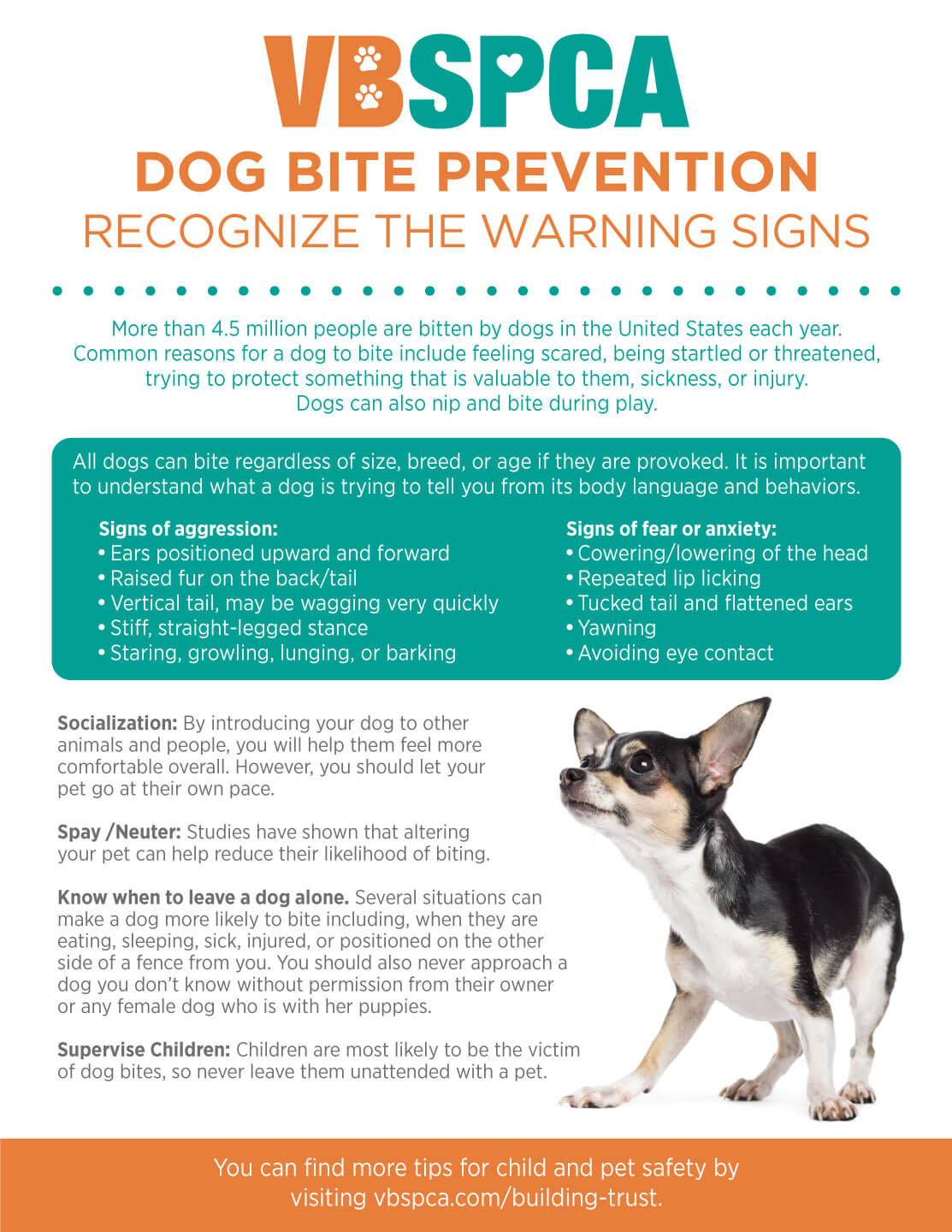According to the Centers for Disease Control and Prevention, more than 4.5 million people are bitten by dogs in the United States each year, and more than 800,000 seek medical attention for dog bites. Common reasons for a dog to bite include feeling scared, being startled or threatened, trying to protect something that is valuable to them (like food or toys), sickness, or injury. Dogs can also nip and bite during play.
All dogs can bite regardless of size, breed, or age if they are provoked. While there are simple things pet parents can do to prevent dog bites from happening, it is equally important to first understand what a dog is trying to tell you from their body language and behaviors.
What Dogs are Trying to Tell You
By paying close attention to a dog’s body language and behavior, you will be much less likely to be bitten. The ASPCA has listed the following signs of aggression, fear, or anxiety, which are feelings that can lead to a bite.
Signs of aggression include efforts to make the dog look bigger:
- Ears positioned upward and forward
- Raised fur on the back and/or tail
- Vertical tail, may be wagging very quickly
- Stiff, straight-legged stance
- Staring
- Growling, lunging, or barking
Signs of fear or anxiety include efforts to make the dog look smaller:
- Cowering and/or lowering of the head
- Repeated lip licking
- Tucked tail
- Flattened ears
- Yawning
- Avoiding eye contact
- Remaining very still
- Growling or snarling
If you encounter any of these signs, it is best to give the dog some space.
What You Can Do to Prevent Dog Bites
Aside from reading a dog’s body language, there are things you can do to reduce the chance of the dog biting you or someone else.
- Socialize your dog. By introducing your dog to other animals and people, you will help them feel more comfortable overall. Familiarizing your dog with everyday situations will make them less likely to become fearful and bite. However, you should let your pet go at their own pace. Don’t force them to interact with other people and animals when they are uncomfortable.
- Spay or neuter your dog. Studies have shown that altering your pet can help reduce their likelihood of biting.
- Know when to leave a dog alone. There are several situations that can make a dog more likely to bite. Those include when he is eating, sleeping, sick, injured, or positioned on the other side of a fence from you. You should also never approach a dog you don’t know without permission from their owner or any female dog who is with her puppies.
- Always supervise children when they are around a dog. Children are most likely to be the victim of dog bites, so do not leave them unattended with a pet. You can find more tips for child and pet safety here.
If you notice your dog has the tendency to be aggressive, fearful, or anxious, consider getting help from a certified trainer. You can find our list of recommended trainers here.





Last Updated: June 2, 2022 by vbspcaadmin
Dog Bite Prevention | Recognize The Warning Signs
According to the Centers for Disease Control and Prevention, more than 4.5 million people are bitten by dogs in the United States each year, and more than 800,000 seek medical attention for dog bites. Common reasons for a dog to bite include feeling scared, being startled or threatened, trying to protect something that is valuable to them (like food or toys), sickness, or injury. Dogs can also nip and bite during play.
All dogs can bite regardless of size, breed, or age if they are provoked. While there are simple things pet parents can do to prevent dog bites from happening, it is equally important to first understand what a dog is trying to tell you from their body language and behaviors.
What Dogs are Trying to Tell You
By paying close attention to a dog’s body language and behavior, you will be much less likely to be bitten. The ASPCA has listed the following signs of aggression, fear, or anxiety, which are feelings that can lead to a bite.
Signs of aggression include efforts to make the dog look bigger:
Signs of fear or anxiety include efforts to make the dog look smaller:
If you encounter any of these signs, it is best to give the dog some space.
What You Can Do to Prevent Dog Bites
Aside from reading a dog’s body language, there are things you can do to reduce the chance of the dog biting you or someone else.
If you notice your dog has the tendency to be aggressive, fearful, or anxious, consider getting help from a certified trainer. You can find our list of recommended trainers here.
Category: VBSPCA News
Search
Ways to Give
Annual Sponsors
To view our Donor Privacy Policy, click here.